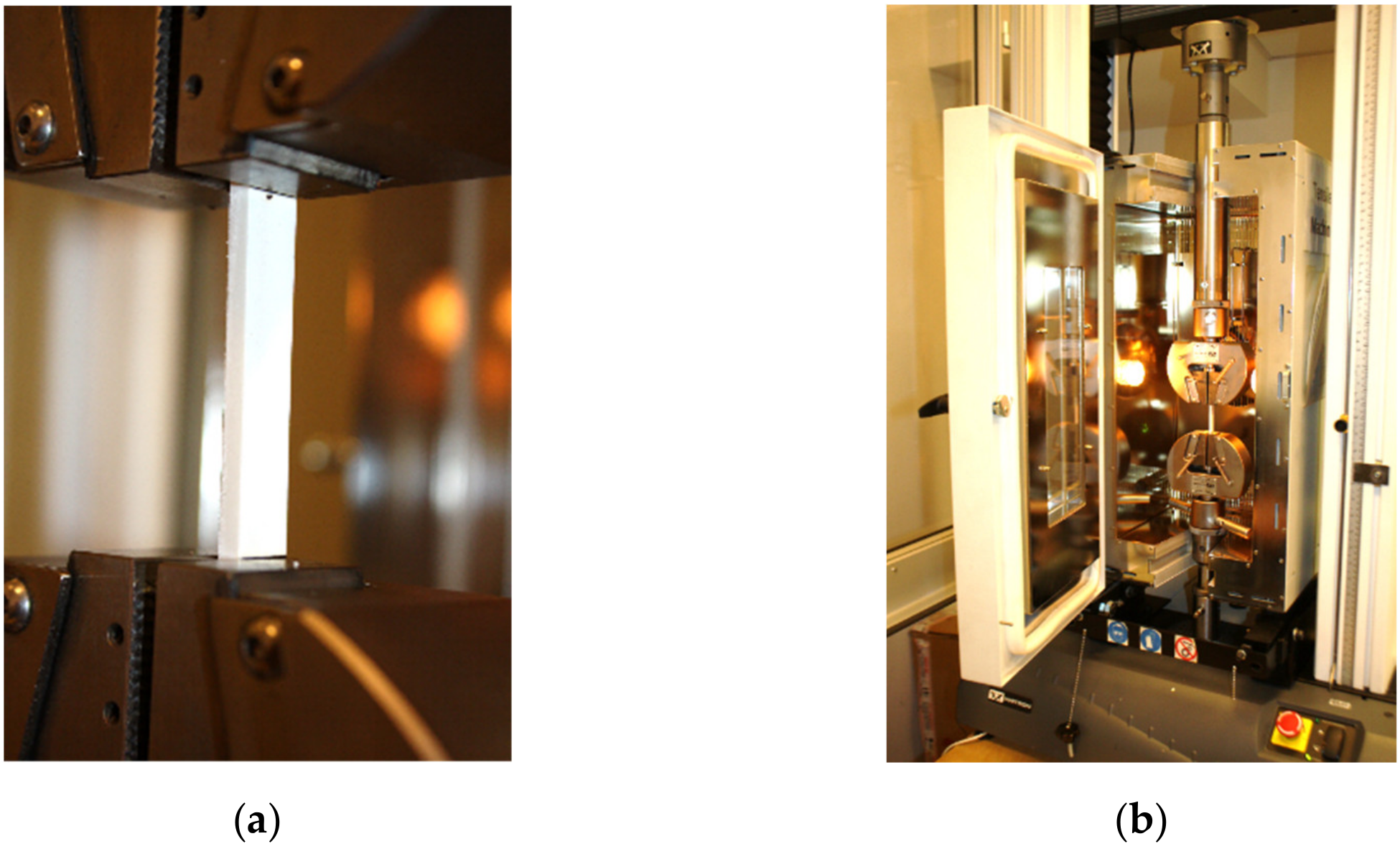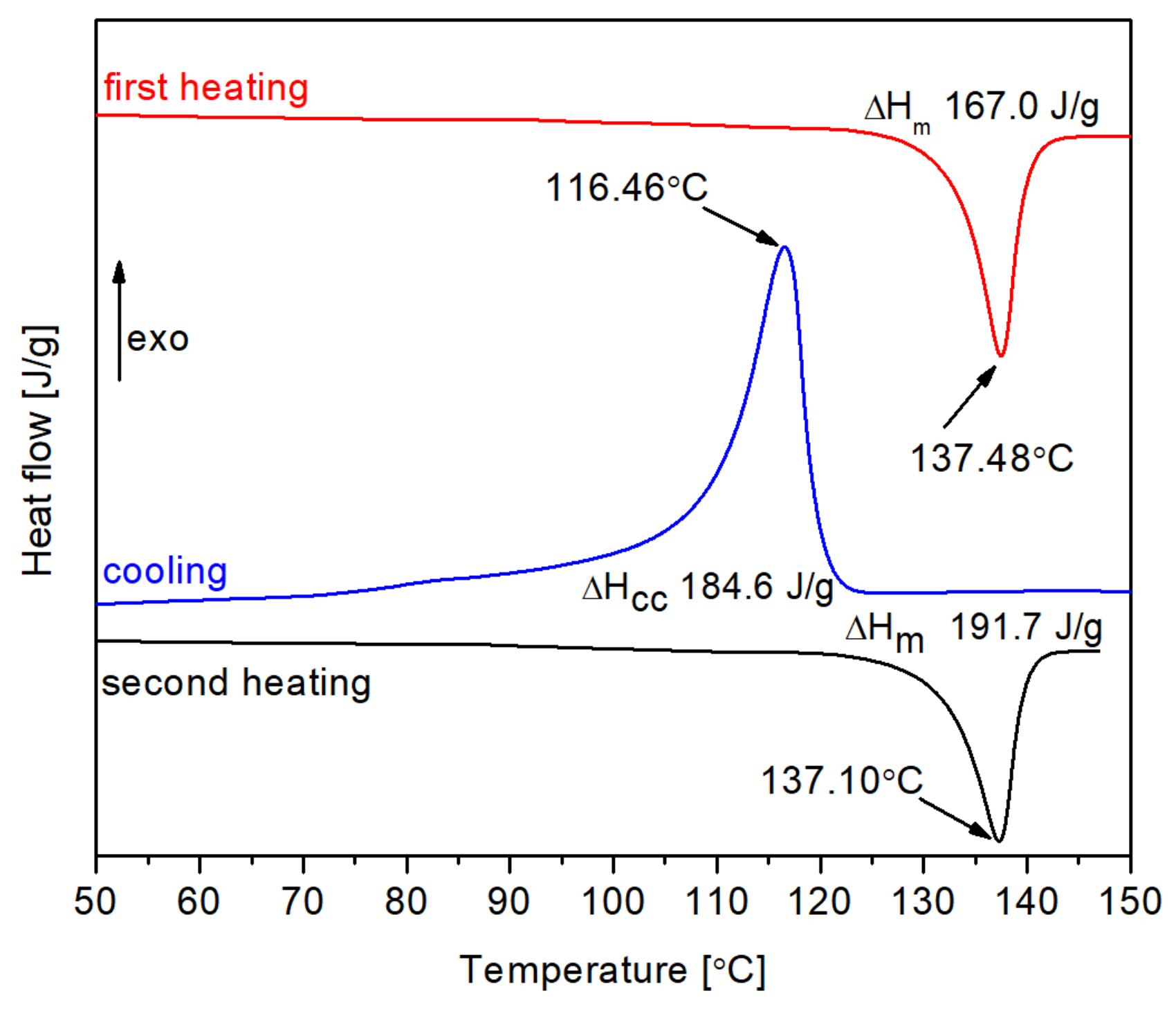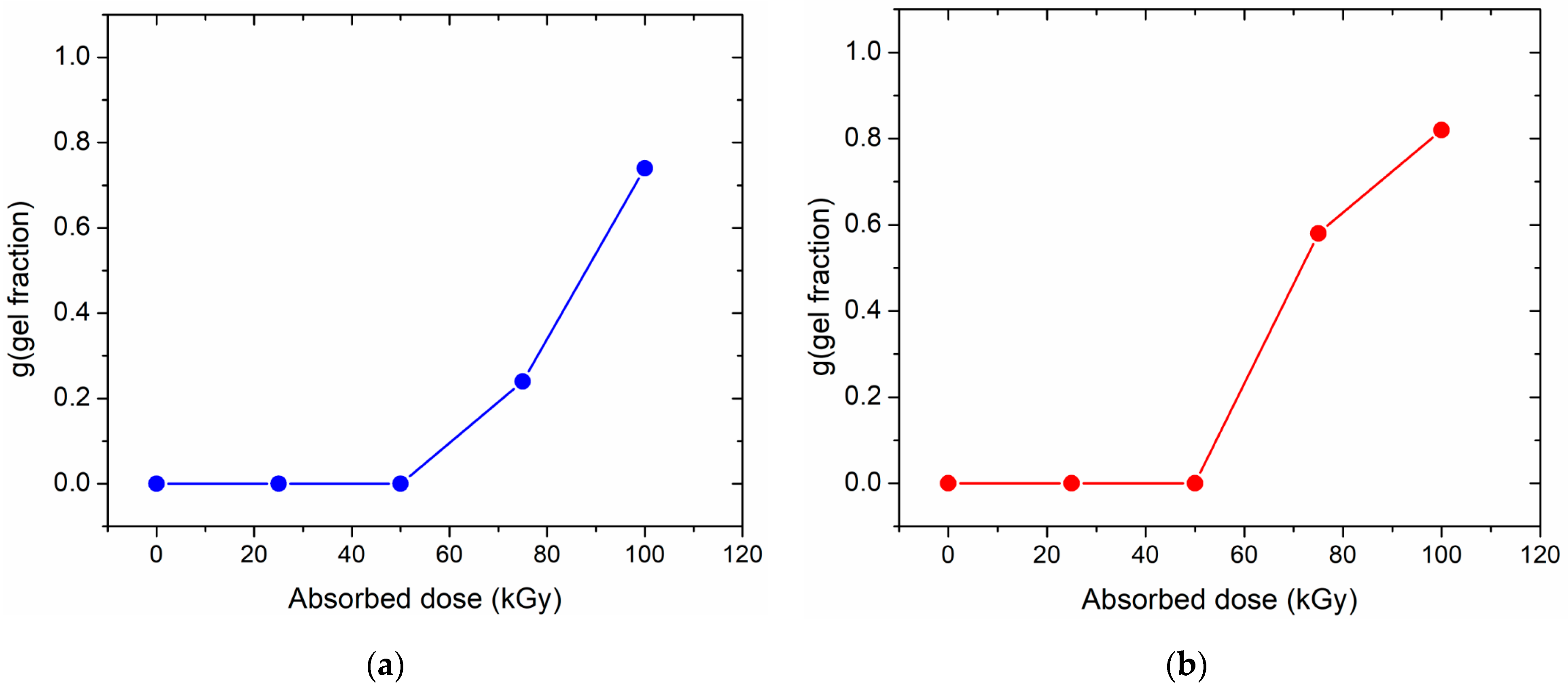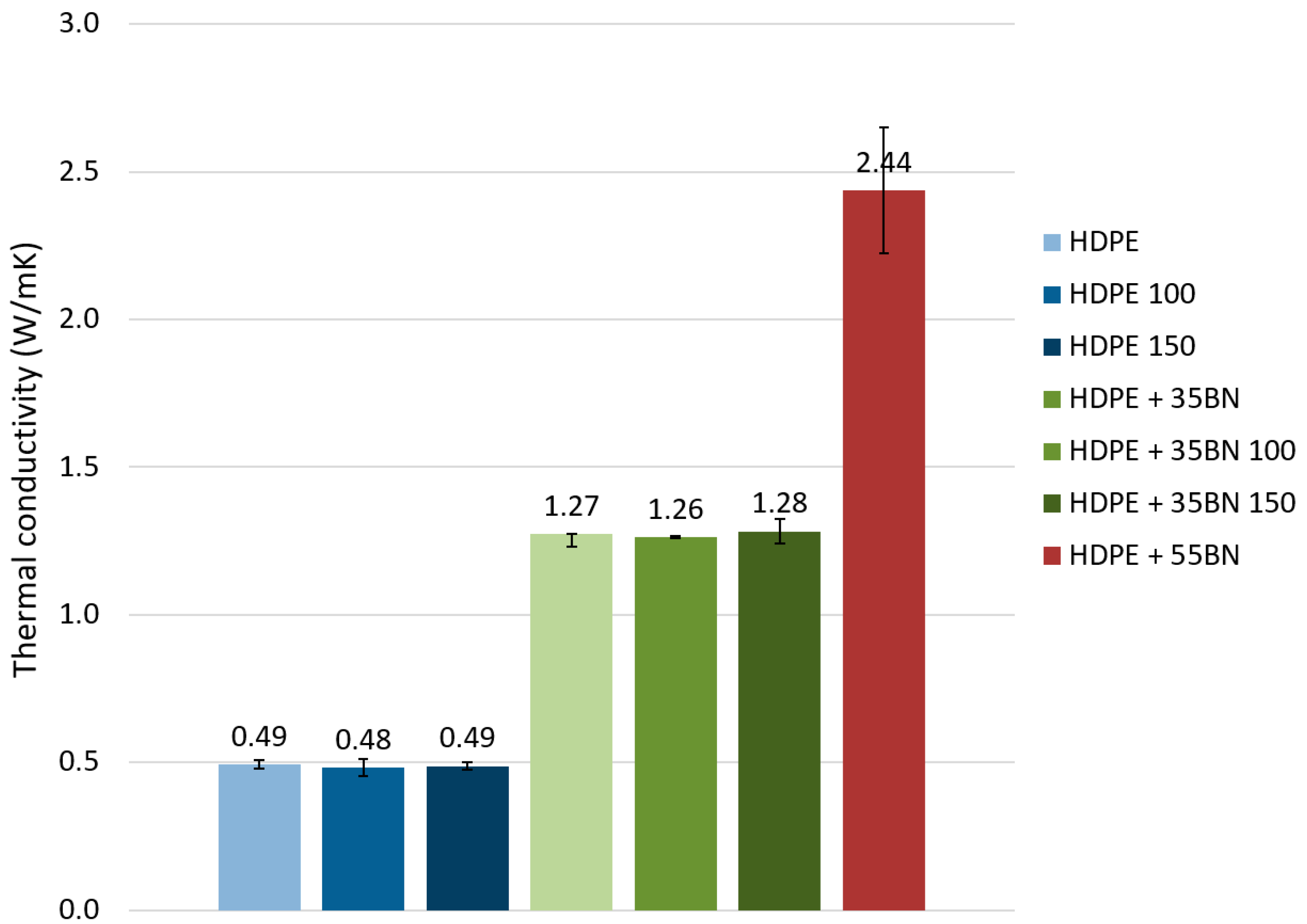Thermally Conductive Shape Memory Polymer Composites Filled with Boron Nitride for Heat Management in Electrical Insulation
Abstract
:1. Introduction
2. Materials and Methods
2.1. Materials Used
2.1.1. Polymer Matrix
- Density: 0.960 g/cm3;
- Tensile Modulus: 1450 MPa;
- Tensile Stress: 30 MPa;
- Vicat Softening Temperature: 74 °C;
- Polymer has a form of white pellets with diameter of ca. 3 mm.
2.1.2. Filler
2.2. Crosslinking of Pellets
2.2.1. Electron Beam (EB) Irradiation
2.2.2. Gamma Ray Irradiation
2.3. Characterization of HDPE Pellets
2.3.1. Thermal Properties and Crystallinity
2.3.2. Qualitative Crosslinking Tests
2.3.3. Quantitative Crosslinking Tests
2.4. Manufacturing of BN Filled HDPE Composites
2.4.1. Samples Preparation
- Pure HDPE;
- HDPE + 35 wt.% BN;
- HDPE + 55 wt.% BN.
2.4.2. Crosslinking of Rectangular Composite Samples
2.5. Shape Memory Tests
- 1.
- At the beginning, all the samples were subsequently fixed between holders of the tensile machine Instron 3367 and closed in oven as shown in Figure 2.
- 2.
- 3.
- In order to freeze the sample in elongated state and create the temporary forms of the investigated SMP, the samples were still kept stretched and cooled to reach room temperature, and then removed from holders: hereinafter referred to as a 1st stage.
- 4.
- The change of stretched distance was measured after 1st stage.
- 5.
- As the next step, the free-standing samples were heated again to temperature of 125 °C for 15 min and cooled to room temperature: hereinafter referred to as a 2nd stage.
- 6.
- Finally, the recovery of the stretched length after 2nd stage was measured.
2.6. Thermal Conductivity Measurements
3. Results and Discussion
3.1. Thermal Properties and Crystallinity of the Non-irradiated HDPE
3.2. Qualitative Crosslinking Verification
- formation of a low amount of unsaturated bonds;
- some oxidation;
- presence of residual (trapped) free radicals in the crystalline fraction.
3.3. Quantitative Estimation of Crosslinking
3.4. Effect of Irradiation on Appearance of Samples
- change the crystalline structure and degree of crystallinity of HDPE during the bar manufacturing step (which may result, e.g., in a lower tendency to trap free radicals in the crystalline region);
- act to some extent as a radioprotective agent;
- interfere with irradiated HDPE by partial transfer and/or scavenging of radicals.
3.5. Shape Memory Phenomenon
3.6. Thermal Conductivity Measurements
4. Conclusions
Author Contributions
Funding
Institutional Review Board Statement
Informed Consent Statement
Data Availability Statement
Acknowledgments
Conflicts of Interest
References
- Xie, T. Recent advances in polymer shape memory. Polymer 2011, 52, 4985–5000. [Google Scholar] [CrossRef] [Green Version]
- Rousseau, I.A. Challenges of shape memory polymers: A review of the progress toward overcoming SMP’s limitations. Polym. Eng. Sci. 2008, 48, 2075–2089. [Google Scholar] [CrossRef]
- Heat Shrink Technology. Available online: https://www.te.com/global-en/industries/energy-solutions/heat-shrink-technology.html (accessed on 24 May 2021).
- Heat Shrink Tubing and Heat Shrink Moulded Shapes. Available online: https://www.hellermanntyton.com/competences/heat-shrink-tubing (accessed on 24 May 2021).
- Rybak, A.; Nieroda, J. Aluminosilicate-epoxy resin composite as novel material for electrical insulation with enhanced mechanical properties and improved thermal conductivity. Polym. Compos. 2019, 40, 3182–3188. [Google Scholar] [CrossRef]
- Rybak, A.; Jarosinski, L.; Gaska, K.; Kapusta, C. Graphene nanoplatelet-silica hybrid epoxy composites as electrical insulation with enhanced thermal conductivity. Polym. Compos. 2018, 39, E1682–E1691. [Google Scholar] [CrossRef]
- Rybak, A.; Gaska, K.; Kapusta, C.; Toche, F.; Salles, V. Epoxy composites with ceramic core–shell fillers for thermal management in electrical devices. Polym. Adv. Technol. 2017, 28, 1676–1682. [Google Scholar] [CrossRef]
- Jarosinski, L.; Rybak, A.; Gaska, K.; Kmita, G.; Porebska, R.; Kapusta, C. Enhanced thermal conductivity of graphene nanoplatelets epoxy composites. Mater. Sci. Pol. 2017, 35, 382–389. [Google Scholar] [CrossRef] [Green Version]
- Goc, K.; Gaska, K.; Klimczyk, K.; Wujek, A.; Prendota, W.; Jarosinski, L.; Rybak, A.; Kmita, G.; Kapusta, C. Influence of magnetic field-aided filler orientation on structure and transport properties of ferrite filled composites. J. Magn. Magn. Mater. 2016, 419, 345–353. [Google Scholar] [CrossRef]
- Gaska, K.; Rybak, A.; Kapusta, C.; Sekula, R.; Siwek, A. Enhanced thermal conductivity of epoxy–matrix composites with hybrid fillers. Polym. Adv. Technol. 2014, 26, 26–31. [Google Scholar] [CrossRef]
- Rybak, A.; Gaska, K. Functional composites with core–shell fillers: I. Particle synthesis and thermal conductivity measurements. J. Mater. Sci. 2015, 50, 7779–7789. [Google Scholar] [CrossRef]
- Gaska, K.; Kmita, G.; Rybak, A.; Sekula, R.; Goc, K.; Kapusta, C. Magnetic-aligned, magnetite-filled epoxy composites with enhanced thermal conductivity. J. Mater. Sci. 2015, 50, 2510–2516. [Google Scholar] [CrossRef]
- Rybak, A. Processing influence on thermal conductivity of polymer nanocomposites. In Processing of Polymer Nanocomposites; Kenig, S., Ed.; Carl Hanser Verlag GmbH & Co. KG: Munich, Germany, 2019; pp. 463–487. [Google Scholar] [CrossRef]
- Pleşa, I.; Noţingher, P.V.; Stancu, C.; Wiesbrock, F.; Schlögl, S. Polyethylene nanocomposites for power cable insulations. Polymers 2019, 11, 24. [Google Scholar] [CrossRef] [PubMed] [Green Version]
- Song, S.; Zhao, H.; Yao, Z.; Yan, Z.; Yang, J.; Wang, X.; Zhao, X. Enhanced electrical properties of polyethylene-graft-polystyrene/LDPE composites. Polymers 2020, 12, 124. [Google Scholar] [CrossRef] [PubMed] [Green Version]
- Florkowska, B.; Roehrich, J.; Zydron, P.; Florkowski, M.; Rybak, A. Interaction of conductor with polymeric materials (XLPE/EPR) at partial discharges. IEEE Trans. Dielectr. Electr. Insul. 2012, 19, 2119–2127. [Google Scholar] [CrossRef]
- Florkowski, M.; Florkowska, B.; Rybak, A.; Zydron, P. Metal migration at conductor/XLPE interface subjected to partial discharges at different electrical stresses. IEEE Trans. Dielectr. Electr. Insul. 2015, 22, 456–462. [Google Scholar] [CrossRef]
- Roja, Z.; Reinholds, I.; Zicāns, J.; Merijs, M.R. Mechanical and heat shrinkable properties of electron beam irradiated polypropylene with Bisphenol A dimethacrylate crosslinker. Mater. Sci. Appl. Chem. 2017, 34, 34–37. [Google Scholar] [CrossRef] [Green Version]
- Reinholds, I.; Kalkis, V.; Merijs-Meri, R.; Zicans, J.; Grigalovica, A. Heat shrinkable behavior, physico-mechanical and structure properties of electron beam cross-linked blends of high-density polyethylene with acrylonitrile-butadiene rubber. Radiat. Phys. Chem. 2016, 120, 56–62. [Google Scholar] [CrossRef]
- Chmielewski, A.G.; Al-Sheikhly, M.; Berejka, A.J.; Cleland, M.R.; Antoniak, M. Recent developments in the application of electron accelerators for polymer processing. Radiat. Phys. Chem. 2014, 94, 147–150. [Google Scholar] [CrossRef]
- Ali, Z.I.; Youssef, H.A.; Said, H.M.; Saleh, H.H. Influence of electron beam irradiation and polyfunctional monomer loading on the physico-chemical properties of polyethylene/polypropylene blends. Adv. Polym. Technol. 2006, 25, 208–217. [Google Scholar] [CrossRef]
- Elshereafy, E.; Mohamed, M.A.; El-Zayat, M.M.; El Miligy, A.A. Gamma radiation curing of nitrile rubber/high density polyethylene blends. J. Radioanal. Nucl. Chem. 2012, 293, 941–947. [Google Scholar] [CrossRef]
- Huang, X.; Kim, C.; Jiang, P. Effects of high-dose gamma ray irradiation on the physicochemical properties and water-treeing deterioration of cross-linked polyethylene cable insulation. IEEE Electr. Insul. Mag. 2011, 27, 17–25. [Google Scholar] [CrossRef]
- Perez, C.J.; Vallés, E.M.; Failla, M.D. The effect of post-irradiation annealing on the crosslinking of high-density polyethylene induced by gamma-radiation. Radiat. Phys. Chem. 2010, 79, 710–717. [Google Scholar] [CrossRef]
- Koerner, H.; Price, G.; Pearce, N.; Alexander, M.; Vaia, R.A. Remotely actuated polymer nanocomposites—stress-recovery of carbon-nanotube-filled thermoplastic elastomers. Nat. Mater. 2004, 3, 115–120. [Google Scholar] [CrossRef]
- Cao, F.; Jana, S.C. Nanoclay-tethered shape memory polyurethane nanocomposites. Polymer 2007, 48, 3790–3800. [Google Scholar] [CrossRef]
- Ohki, T.; Ni, Q.Q.; Ohsako, N.; Iwamoto, M. Mechanical and shape memory behavior of composites with shape memory polymer. Compos. Part A Appl. Sci. 2004, 35, 1065–1073. [Google Scholar] [CrossRef]
- Liu, Y.; Gall, K.; Dunn, M.L.; McCluskey, P. Thermomechanics of shape memory polymer nanocomposites. Mech. Mater. 2004, 36, 929–940. [Google Scholar] [CrossRef]
- Gall, K.; Dunn, M.L.; Liu, Y. Internal stress storage in shape memory polymer nanocomposites. Appl. Phys. Lett. 2004, 85, 290–292. [Google Scholar] [CrossRef] [Green Version]
- MITR—Lodz University of Technology—The Faculty of Chemistry. Available online: http://www.mitr.p.lodz.pl/e_aparat.php?id=5 (accessed on 25 May 2021).
- Adamus-Wlodarczyk, A.; Wach, R.A.; Ulanski, P.; Rosiak, J.M.; Socka, M.; Tsinas, Z.; Al-Sheikhly, M. On the mechanisms of the effects of ionizing radiation on diblock and random copolymers of poly(lactic acid) and poly(trimethylene carbonate). Polymers 2018, 10, 672. [Google Scholar] [CrossRef] [PubMed] [Green Version]
- Matusiak, M.; Kadlubowski, S.; Ulanski, P. Radiation-induced synthesis of poly(acrylic acid) nanogels. Radiat. Phys. Chem. 2018, 142, 125–129. [Google Scholar] [CrossRef]
- Adamus, A.; Wach, R.A.; Olejnik, A.K.; Dzierzawska, J.; Rosiak, J.M. Degradation of nerve guidance channels based on a poly(l-lactic acid) poly(trimethylene carbonate) biomaterial. Polym. Degrad. Stabil. 2012, 97, 532–540. [Google Scholar] [CrossRef]
- Oral, E.; Godleski-Beckos, C.; Ghali, B.W.; Lozynsky, A.J.; Muratoglu, O.K. Effect of cross-link density on the high pressure crystallization of UHMWPE. J. Biomed. Mater. Res. 2009, 90B, 720–729. [Google Scholar] [CrossRef] [Green Version]
- Charlesby, A. Atomic Radiation and Polymers; Pergamon Press: Oxford, UK, 1960. [Google Scholar]
- Coqueret, X. Obtaining high-performance polymeric materials by radiation. In Radiation Chemistry: From Basics to Applications in Material and Life Sciences; Spotheim-Maurizot, M., Mostafavi, M., Douki, T., Belloni, J., Eds.; EDP Sciences: Les Ulis, France, 2008; pp. 131–150. [Google Scholar]
- Coqueret, X.; Sabharwal, S.; Khairul Zaman, H.M.D.; Czechowska-Biskup, R.; Wach, R.A.; Rosiak, J.M.; Ulanski, P.; Gulrez, S.K.H.; Al-Assaf, S. Introduction to the radiation chemistry of polymers. In The Radiation Chemistry of Polysaccharides; Al-Assaf, S., Coqueret, X., Khairul Zaman, H.M.D., Sen, M., Ulanski, P., Eds.; International Atomic Energy Agency: Vienna, Austria, 2016; pp. 25–75. [Google Scholar]
- Oral, E.; Muratoglu, O.K. Radiation cross-linking in ultra-high molecular weight polyethylene for orthopaedic applications. Nucl. Instr. Meth. B 2007, 265, 18–22. [Google Scholar] [CrossRef] [PubMed] [Green Version]
- Rosiak, J.; Olejniczak, J.; Charlesby, A. Determination of the radiation yield of hydrogels crosslinking. Radiat. Phys. Chem. 1988, 32, 691–694. [Google Scholar] [CrossRef]
- Sohma, J.; Chen, Q.; Wang, Y.; Qu, X.-W.; Shiotani, M. Solid-state high-resolution 13C-NMR study of crosslinks in heavily gamma-irradiated polyethylene. Radiat. Phys. Chem. 1991, 37, 47–51. [Google Scholar] [CrossRef]
- Andjelić, S.; Richard, R.E. Crystallization behavior of ultrahigh molecular weight polyethylene as a function of in vacuo γ-irradiation. Macromolecules 2001, 34, 896–906. [Google Scholar] [CrossRef]
- Blackburn, R.; Charlesby, A.; Woods, R.J. A comparison of the effects of α and γ irradiation on the crystallinity of polyethylene. Eur. Polym. J. 1965, 1, 161–172. [Google Scholar] [CrossRef]
- Gao, Y.; Xu, B.; Han, T.; Wang, X. Gamma-ray irradiation induced variation in charge transport behavior of polyethylene based boron nitride/silica micro/nanocomposites. IEEE Trans. Dielectr. Electr. Insul. 2020, 27, 459–467. [Google Scholar] [CrossRef]
- Harrison, C.; Weaver, S.; Bertelsen, C.; Burgett, E.; Hertel, N.; Grulke, E. Polyethylene/boron nitride composites for space radiation shielding. J. Appl. Polym. Sci. 2008, 109, 2529–2538. [Google Scholar] [CrossRef]
- Shang, Y.; Yang, G.; Su, F.; Feng, Y.; Ji, Y.; Liu, D.; Yin, R.; Liu, C.; Shen, C. Multilayer polyethylene/hexagonal boron nitride composites showing high neutron shielding efficiency and thermal conductivity. Compos. Commun. 2020, 19, 147–153. [Google Scholar] [CrossRef]
- Gaska, K.; Kádár, R.; Rybak, A.; Siwek, A.; Gubanski, S. Gas barrier, thermal, mechanical and rheological properties of highly aligned graphene-LDPE nanocomposites. Polymers 2017, 9, 294. [Google Scholar] [CrossRef]
- Keshtkar, M.; Mehdipour, N.; Eslami, H. Thermal conductivity of polyamide-6,6/carbon nanotube composites: Effects of tube diameter and polymer linkage between tubes. Polymers 2019, 11, 1465. [Google Scholar] [CrossRef] [Green Version]
- Eslami, H.; Mohammadzadeh, L.; Mehdipour, N. Anisotropic heat transport in nanoconfined polyamide-6,6 oligomers: Atomistic reverse nonequilibrium molecular dynamics simulation. J. Chem. Phys. 2012, 136, 104901. [Google Scholar] [CrossRef] [PubMed]





| Sample Name | BN Content (wt.%) | Gamma Irradiation Dose (kGy) |
|---|---|---|
| HDPE | 0 | - |
| HDPE 100 | 0 | 100 |
| HDPE 150 | 0 | 150 |
| HDPE + 35BN | 35 | - |
| HDPE + 35BN 100 | 35 | 100 |
| HDPE + 35BN 150 | 35 | 150 |
| HDPE + 55BN | 55 | - |
| HDPE + 55BN 100 | 55 | 100 |
| HDPE + 55BN 150 | 55 | 150 |
| Dose (kGy) | 0 | 25 | 50 | 75 | 100 |
|---|---|---|---|---|---|
| Electron beam | - | - | +/− 1 | + | + |
| Gamma rays | - | - | +/− | + | + |
| Area Length 1 (mm) | HDPE 100 | HDPE 150 | HDPE + 35BN 100 | HDPE + 35BN 150 |
|---|---|---|---|---|
| Initial | 50.00 | 50.00 | 50.00 | 50.00 |
| Stretched | 55.00 | 55.00 | 55.00 | 55.00 |
| After 1st stage | 52.61 | 52.55 | 53.19 | 53.07 |
| After 2nd stage | 50.18 | 50.11 | 50.81 | 50.68 |
| Shape recovery 2 (%) | 99.64 | 99.78 | 98.41 | 98.66 |
Publisher’s Note: MDPI stays neutral with regard to jurisdictional claims in published maps and institutional affiliations. |
© 2021 by the authors. Licensee MDPI, Basel, Switzerland. This article is an open access article distributed under the terms and conditions of the Creative Commons Attribution (CC BY) license (https://creativecommons.org/licenses/by/4.0/).
Share and Cite
Rybak, A.; Malinowski, L.; Adamus-Wlodarczyk, A.; Ulanski, P. Thermally Conductive Shape Memory Polymer Composites Filled with Boron Nitride for Heat Management in Electrical Insulation. Polymers 2021, 13, 2191. https://doi.org/10.3390/polym13132191
Rybak A, Malinowski L, Adamus-Wlodarczyk A, Ulanski P. Thermally Conductive Shape Memory Polymer Composites Filled with Boron Nitride for Heat Management in Electrical Insulation. Polymers. 2021; 13(13):2191. https://doi.org/10.3390/polym13132191
Chicago/Turabian StyleRybak, Andrzej, Lukasz Malinowski, Agnieszka Adamus-Wlodarczyk, and Piotr Ulanski. 2021. "Thermally Conductive Shape Memory Polymer Composites Filled with Boron Nitride for Heat Management in Electrical Insulation" Polymers 13, no. 13: 2191. https://doi.org/10.3390/polym13132191
APA StyleRybak, A., Malinowski, L., Adamus-Wlodarczyk, A., & Ulanski, P. (2021). Thermally Conductive Shape Memory Polymer Composites Filled with Boron Nitride for Heat Management in Electrical Insulation. Polymers, 13(13), 2191. https://doi.org/10.3390/polym13132191







